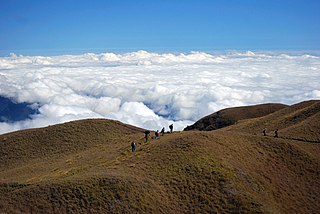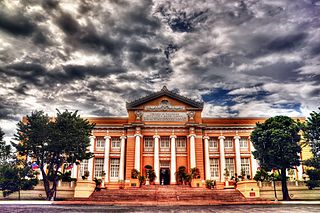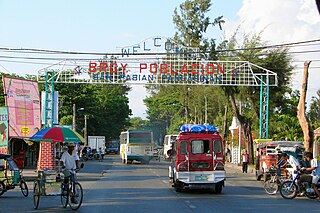
La Union, officially the Province of La Union, is a province in the Philippines located in the Ilocos Region in the Island of Luzon. Its capital is the City of San Fernando, which also serves as the regional center of the Ilocos Region.

Benguet, officially the Province of Benguet, is a landlocked province of the Philippines located in the southern tip of the Cordillera Administrative Region in the island of Luzon. Its capital is La Trinidad.

The Ilocos Region, designated as Region I, is an administrative region of the Philippines. Located in the northwestern section of Luzon, it is bordered by the Cordillera Administrative Region to the east, the Cagayan Valley to the northeast and southeast, Central Luzon to the south, and the South China Sea to the west.

Sison, officially the Municipality of Sison, is a 3rd class municipality in the province of Pangasinan, Philippines. The town's original name was Alava. According to the 2020 census, it has a population of 52,320 people.

Pangasinan, officially the Province of Pangasinan, is a coastal province in the Philippines located in the Ilocos Region of Luzon. Its capital is Lingayen. Pangasinan is in the western area of Luzon along Lingayen Gulf and the South China Sea. It has a total land area of 5,451.01 square kilometres (2,104.65 sq mi). According to the 2020 census, it has a population of 3,163,190. The official number of registered voters in Pangasinan is 1,651,814. The western portion of the province is part of the homeland of the Sambal people, while the central and eastern portions are the homeland of the Pangasinan people. Due to ethnic migration, the Ilocano people settled in the province.

Lingayen, officially the Municipality of Lingayen, is a 1st class municipality and capital of the province of Pangasinan, Philippines. According to the 2020 census, it has a population of 107,728 people.

San Fabian, officially the Municipality of San Fabian, is a 1st class municipality in the province of Pangasinan, Philippines. According to the 2020 census, it has a population of 87,428 people.

The legislative districts of Laguna are the representations of the province of Laguna in the various national legislatures of the Philippines. The province is currently represented in the lower house of the Congress of the Philippines through its first, second, third, and fourth congressional districts.
The flags of the provinces of the Philippines are the vexillological devices used by various provincial-level local government units (LGUs) of the country.
Sangguniang Panlalawigan, commonly known as the Provincial Board, are the legislatures in Philippine provinces. They are the legislative branches of the provinces, and their powers and responsibilities are defined by the Local Government Code of 1991. Along with the provincial governor, the executive branch of the province, they form the province's government.
The Sangguniang Bayan is the local legislative branch of the municipal governments in the Philippines. It is responsible for passing ordinances and resolutions for the administration of a municipality. Its powers are defined by the Local Government Code, passed by Congress in 1991.

"O, Capiz", also known as the Capiz Hymn, is the official provincial anthem of the province of Capiz in the Philippines.

Urduja House, previously known as Urduja Palace, is the official residence of the governor of Pangasinan. Built across the Pangasinan Provincial Capitol in 1953, it has been home to subsequent governors since as their residence while in the capital.

Alma Uy-Lampasa is a Filipino law professor, judge and politician who served as a provincial board member of the 2nd legislative district of Samar.
"Imno ning Kapampangan", also known as the Pampanga Hymn, is the official anthem of the province of Pampanga in the Philippines.
The "Vizcaya Hymn" is the official anthem of the province of Nueva Vizcaya in the Philippines.

The Seal of Nueva Vizcaya is the seal used by the provincial government of Nueva Vizcaya in the Philippines.
The "La Union Hymn" is the official anthem of the province of La Union in the Philippines.
"Albay Forever", also known as the Albay Hymn or the Albay Provincial Hymn, is the official anthem of the province of Albay in the Philippines.












